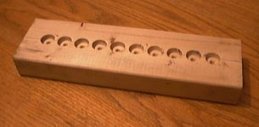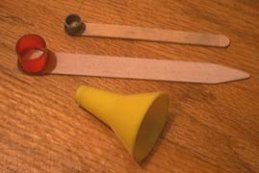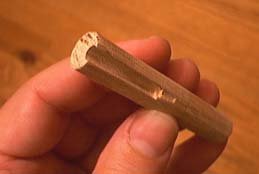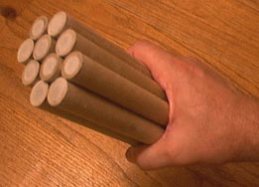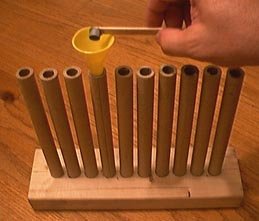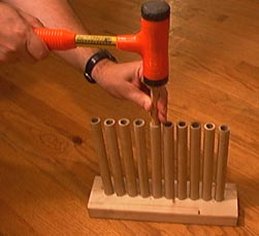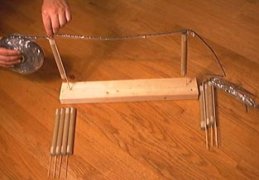Roman candles
From PyroGuide
Roman candles are a type of fireworks, with long, thick paper tubes that contain layers of "stars" and lifting charges.
The device is ignited from the top. The delay powder is packed tightly in the tube, so that the flame cannot reach around the sides of the plug of delay composition. It therefore burns slowly; as it is consumed, the flame moves down through the tube. When the flame reaches the topmost pyrotechnic star, the star is ignited. Because the star fits loosely in the tube, the fire spreads all around it and ignites the lift charge. The lift charge burns quickly, propelling the star out of the tube, like a bullet from a gun. In doing so it also ignites the layer of delay powder beneath it, and the process repeats.
There are several variations on this:
- Many Chinese Roman candles use clay instead of delay powder and run a length of fuse down the inside of the candle to time the lifts.
- Larger Roman candles will usually add more lift to the highest layers and less to the lower layers in order to cause the stars to lift to the same altitude.
- Some really large candles will load comet shells instead of stars.
Roman candles are banned in for example Finland due to them being considered prone to accidents.
[edit] Tutorial
| This project requires the building of 20 candles which use 1/2 inch I.D. tubes. When making so many identical items, it helps to make a little tooling that lends itself to high efficiency mass production. Otherwise, you might expire from the shear boredom of repeating each step an endless number of times. First, a simple stand is made from a piece of scrap 2 by 4 by drilling 10 holes in a row to hold the tubes in a vertical position. | |
| The remainder of the tooling consists of a specialized funnel, a lift charge scoop, a delay composition scoop and a few rammers. The funnel is chosen to fit snugly into the tubes and be able to remain in place without falling out. The mouth of the funnel has been greatly reduced to make it less cumbersome. The lift powder scoop may need to be tailored to the strength of your powder, but this one measures slightly less than 1/8 teaspoon of volume. It was made using a short length of plastic tubing scavenged from the snap-on cover of a BIC pen. This was then hot glued to a common popsicle stick. The delay composition scoop measures roughly 3/4 teaspoon of volume. Try to use as little delay composition as possible to prevent the fire from passing too quickly between star shots. This allows the loading of more stars per candle, but if too little is used to form an adequate seal, the candle can end up sounding like a machine gun. This effect may be worth exploring if you want to put up a lot of stars in a hurry, but for candles, the desire is to have enough delay so that a new star is ejected approximately when the previous one burns out. | |
| The tooling is completed by making a few rammers. The main candle rammer is made by starting with an 11 inch length of 1/2 inch hardwood dowel that fits snugly inside the candle tubes. Any of several means is used to sand down the surface of the dowel until the "handle" portion of the rammer measures about 7/16 inches in outside diameter. Only the final 1/2 inch of the ramming end is left at its original diameter. This rammer will now be much easier to insert and retract from the candle tubes. The fuse rammer is made by cutting a 4 inch length of the same dowel material. A fuse hole is drilled into the end of the dowel to a depth of about 1 1/4 inches as shown in the photo. This is accomplished by inserting the dowel into a 1/2 inch hole drilled into a piece of scrap wood until the dowel end is flush with the surface of the wood scrap. The scrap is then clamped to the deck of a drill press with the dowel protruding downward and the fuse hole is drilled along the edge of the dowel as illustrated. | |
| This project uses tubes that are 1/2 inch ID and 8 inches long. Each of them needs an end plug of clay before the flammable contents can be added. Many combinations of clay and grog are possible. In this project it consists of 50% fine bentonite clay powder and 50% kyanite (-48 mesh) from the local pottery supply store. This mix is then treated with an additional 5% of toilet bowl wax dissolved in Coleman fuel. Using the delay composition scoop, a scoop full of this clay mix is then rammed into the end of each candle to form a very uniform and solidly sealed end plug. | |
| Next, 10 of the plugged candle tubes are inserted into the mass production stand and the funnel is placed into the top of the first one. The funnel has the duel purpose of aiding in the quick loading of the powders into the tubes and serving as a place marker to keep track of which tube needs to be charged at what time. Without this little mental aid, it's very easy to loose your place. The first lift charge is placed in each tube with the following cyclical sequence of motions: load the scoop, dump the scoop into the funnel, move the funnel to the next tube in line. | |
| Now a star is dropped into each tube. Count out exactly 10 stars and hold them all in one hand, at once drop them into the tubes, one at a time. This way, you never have to take your eyes away from the tubes and risk loosing my place. Probably the best suited kind of star to use for roman candles is the kind that is made with the use of a star plate because they end up being cylindrical in shape. The stars shown in this picture are 3/8 inch "Improved Snowball" stars that were made using a plexiglass star plate. They have enough clearance in the candle tube to easily drop all the way to the bottom without getting stuck. Other kinds of stars will work nearly as well. You can even use round stars and even cubical cut stars. | |
| Now, another scoop of lift powder is added to each tube with the repeated cycle of motions described above. The base board is then tapped a few times to encourage the powder to settle down around the sides of each star. The amount of lift powder added may vary, depending on the geometry of the stars that are used. The idea is to fill all the space around the star so that the star is completely encased in lift powder. The lift powder at the sides of the star will quickly pass the fire down to the lift powder underneath the star which propels the burning star out of the tube. Some may use a different grain size powder or a different composition for the pass fire function, but use the same for both functions to simplify the assembly process. | |
| The next step is to add a delay composition on top of each star. The delay composition scoop is used to do this in exactly the same manner that the lift powder was added, with the funnel acting as a place marker. After the delay composition has been added, it must be compacted by ramming to seal the tube and prevent fire from prematurely reaching the next star. This needs to be done consistently and uniformly by using the same number of ramming blows with equal force each time. Use 4 blows with a 16 oz. dead blow hammer using only the wrist as a pivot point. The wooden rammer is then lifted, rotated 1/2 turn and pushed down again. Four more wrist blows of the hammer complete the compaction of the delay composition. | |
| The next task is to secure a short length of fuse into the end of each candle. Black match will work well as will visco fuse. Each piece of fuse is cut to a length of 1 1/4 inches. Another scoop of delay comp is added to each candle and a piece of fuse is inserted against the inside surface of each candle tube until about 5/8 to 3/4 inches protrudes from the end. The candle composition is then compacted around the base of the fuse by using the fuse ram as shown. Now, the same process is repeated all over again to make the second batch of candles. | |
| All that remains to complete the candle construction is to attach a bamboo skewer stick to each one with the blunt end of the skewer stick extending above the fused end of the candle by about the same distance as the fuse. If verbal description has confused you, the picture should make it much clearer. A short piece of masking tape at the top and bottom does the job nicely. The idea, here, is to give a lot of rigid support to the fuse so that when the candles are matched together, they can take considerable handling abuse without dislodging the fuse from the end of the candle. | |
| The choice must now be made whether to match the candles together or wait until the candles are arranged at the display site and do the matching at the site. A prefered method is to match them all together during the construction phase and then bundle the candles all together for temporary storage until show time. This reduces set-up time before the show and also assures a more accurate spacing of the candles. The matching is accomplished by using a board with two holes for the skewers placed at the desired distance between candles. An 18 inch spread between candles will yield a string of candles that is 30 feet long. Two candles are mounted in the skewer holes and sticky match is strung between them from a spool. The sticky part of the match is clamped over both the fuse and the skewer stub. Now, since the candle string is being built to the left, both of the matched candles are removed from the stand and shifted to the right. The left candle which is attached to the sticky match is mounted in the right hole and the right candle is laid down on the table. A new candle is mounted in the left hole and the sticky match is unrolled from the spool to reach the new candle. This cycle is repeated until all the candles are matched. | |
| Here is the finished piece. It has been strapped together with masking tape for easy storage and handling until show time. When setting up the candles for display, there are many options to choose from. The skewers are simply pushed into the ground to arrange the candles in a variety of ways. The "dancing curtain of fire" is achieved with a straight line of candles all positioned vertically. The "sparkling daisy" is accomplished with a circle of candles aimed outward at about 45 degrees. Another option is a straight line with alternating candles aiming forward and backward. The forward candles fire green stars and the backward candles fire red stars. With different kinds of stars and different arrangements, the possibilities are almost endless. |
- Dan Williams, Amateur Pyrotechnician - http://fogoforum.us/index.html
- Wikipedia - http://en.wikipedia.org/wiki/Roman_candle
